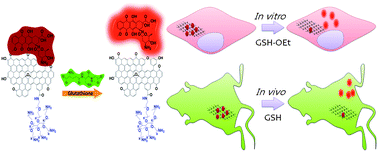Both in vitro and in vivo glutathione (GSH)-triggered anticancer drug releases were monitored in real time from the PEGylated graphene oxide (PEG-GO) platform. The assembly of the anticancer drug doxorubicin (DOX) on PEG-GO was verified by UV-Vis absorption and infrared spectroscopic tools. The fluorescence of DOX appeared to be quenched significantly by PEG-GO. A part of the initial DOX (10−4 M) in PEG-GO was found to be released by ∼23.5% after treatment with 2 mM glutathione (GSH) within 15 min. Our fluorescence colocalization experiments indicated that PEG-GO–DOX was endocytosed and localized in either lysosomes or endosomes of intracellular compartments. Using fluorescence imaging techniques in real time, we were able to observe an approximately 2.5 times higher in vitro drug release in the live cells by externally triggering glutathione ethyl ester (GSH-OEt) rather than endogeneous GSH. In vivo fluorescence images of DOX were obtained with an order of magnitude larger intensity from the subcutaneous site in living mice after treatment with 0.3 mg of GSH. A real-time release of DOX on PEG-GO at the intended locus can be achieved in vivo after an external triggering of GSH.

